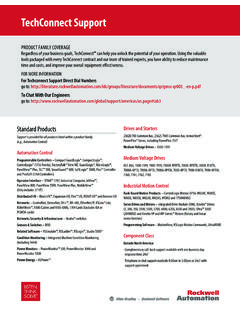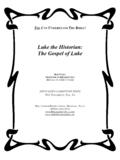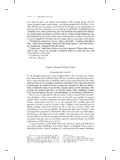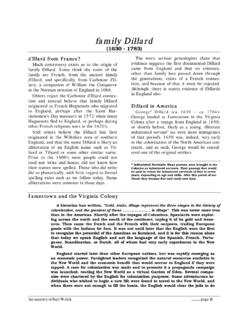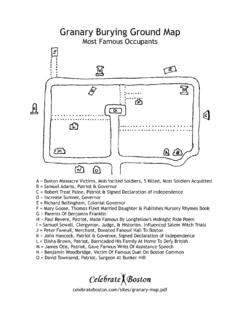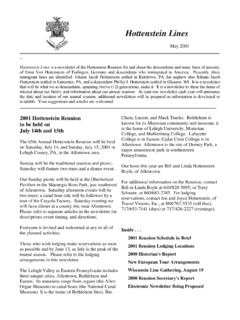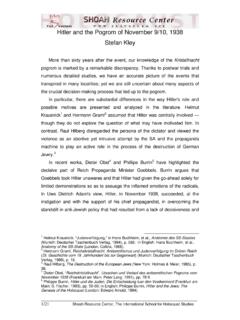Transcription of Profile Series produced by the Mennonite Historian F
1 Moving gesture of reconciliation and strong preaching marked the first full day of Mennonite World Conference (MWC) Assembly 15 held in Asunci n, Paraguay, July 14-19, 2009. Ishmael Noko, general secretary of the Lutheran World Federation (LWF), addressed the gathering with a heavy heart, he said, because of the painful history Lutherans and Mennonites share, especially the persecution and execution of Anabaptists in the 16th century. This history of condoning persecution, he said, is a spiritual wound we carry around in us. He further described the condemnations of Anabap-tists, contained in the anathemas of the Augsburg Confession, as the poison of a scorpion. The Anabaptists did not strike back, he said; we have it in us.
2 We were wrong, regrettably wrong, he said. Execution was not the only choice, even then. In recent years, Mennonites and Lutherans have been in dialogue about these matters, and Lutherans are seeking a healthier continuing dialogue now, said Noko, as we address how we condemned you. At their next meeting, the LWF will be asked to take action which will put us in a new position to the anathemas and express our deep repentance and regret. The assembled Mennonites reacted spontaneously to Noko s words by standing and applauding. MWC president Danisa Ndlovu also responded. What we have heard will change our lives and perspectives, he said. (cont d on p. 9) Dr. Noko Moro Spear Originally published in No Permanent City: Stories from Mennonite History and Life by Harry Loewen.
3 This version adapted from the Profile Series produced by the Mennonite Brethren Historical the time Mennonites first settled in the Paraguayan Chaco in 1928, the Lengua Indians warned them against possible attacks from the Moros (Ayoreo), a warlike tribe living farther north. In 1935 the Mennonites established a mission to the Indians of the Chaco. This Light to the Indians mission included efforts to establish contact with various native peoples, including the Moros. Years went by without any significant contact with the Moros. In 1958 the Mennonite missions committee, based in Filadelfia, decided that the time for more than passing contact had come. Two experienced missionaries were chosen for the undertaking.
4 One was David Hein, married with six children. The other was Kornelius Isaak, also married and with three children. The two, who spoke Spanish but not the Moro language, were eager to go. A Lengua Indian accompanied them on the 225-kilometer journey into the Moro heartland. During the last part of the jeep journey they drove only slowly for the roads were narrow and swampy. Several times they had to dig their vehicle out from the mud. At last they came to a shallow body of water in which fish were found. Suddenly the accompanying Lengua said, There s fire nearby. Leaving the jeep, the missionaries discovered footprints on the ground and a few fires burning here and there. They stuck sticks in the ground, attached shirts to them and then went to an oil company camp nearby.
5 For the next two days they returned to the same sites and each day they left more shirts. The Moros in turn left feathers, an empty wooden bowl and a bag. The meanings of the exchanges were not clear. The Lengua Indian felt uneasy about the signs. The missionaries returned to their home community to report what they had found and to confer with the missions committee and their families. The mission committee counseled caution. In view of the unclear signs and danger, they were not prepared to send the missionaries to the Moros. If they decided to go on their own, however, the committee would support and stand behind them. The families of Hein and Isaak were fearful. But the two men, while concerned about their safety, were eager to continue their mission, come (cont d on p.)
6 2) AFVOL XXXV, NO. 3 - SEPTEMBER 2009 Missionary David Hein with Moro (Ayoreo) natives. The man in centre is Jonoine who killed missionary Kornelius Isaak in 1958. Some 300 members of the Ayoreos are now Christians, the result of efforts by the New Tribes Mission. Photo: CMBS Reconciliation, and a call to practice justiceBy Dora DueckHistorian Mennonite A PUBLICATION OF THE Mennonite HERITAGE CENTRE and THE CENTRE FOR MB STUDIES IN CANADA Page 2 Moro Spear (cont d from p. 1) what might. On September 10, 1958, together with another Lengua companion, they had driven only a few kilometers into the Moro territory when the Indian guide said, There they are. Ahead was a group of some fifty men, scantily clad and apparently without weapons. The missionaries stopped their jeep, got off, and waved to the strangers.
7 The men seemed friendly, came closer and accepted gifts from the missionaries. A tall Moro man approached Kornelius. Looking over the Moro s shoulder, Kornelius noticed those standing farther back were carrying weapons. Things did not bode well. What happened next was sudden. The men shouted insolent words at the missionaries and demanded more gifts. Then one tried to wrestle the Lengua Indian to the ground. The Lengua sought to grab the hunting rifle in the jeep butKornelius Isaak and David Hein, 1950. Photo: CMBS Mennonite Historian is published by the Mennonite Heritage Centre of Mennonite Church Canada and the Centre for Mennonite Brethren Studies of the Canadian Conference of Mennonite Brethren Churches.
8 Editors: Alf Redekopp (MHC) Doug Heidebrecht (CMBS) Associate Editor: Conrad Stoesz (CMBS/MHC)All correspondence and manuscripts should be sent to the editorial offices at: 600 Shaftesbury Blvd. Winnipeg, MB R3P 0M4 P: 204-888-6781 E: W: 1310 Taylor Avenue, Winnipeg, MB R3M 3Z6 P: 204-669-6575 E: W: rates: $ per year, $ for two years, $ for three years. Individual subscriptions may be ordered from these addresses. ISSB 07008066 David Hein with Moro spear that killed Cornelius Isaak. Photo: CMBSwas unable to reach it. David Hein grabbed the rifle and waved it high in the air. When the Moros saw this they retreated, but not before one of them had pointed an arrow at David. He did not release the bow, however.
9 While all of this was going on, Kornelius Isaak felt an intense pain. In the next moment he pulled out a thin spear from his side. No one had seen how it had happened. From all appearances the wound did not seem that serious. Turning the jeep around, Kornelius at the wheel urged that they return to the oil camp as quickly as possible. But after driving only a short distance, Kornelius became so weak that David had to continue driving. From the oil company camp Kornelius was taken by airplane to Filadelfia and admitted to the hospital. The doctors found that his spleen and kidneys were Kornelius & Maria Isaak Family with children: Korni, Rudolf & Rita, 1958. Photo: CMBS badly damaged. The next day, with his wife Marg, his parents, and many friends at his side, Kornelius died.
10 His last words were a prayer for the Moro Indians whom he had tried to reach. The New Tribes Missions and Catholic missionaries continued to work among the Moros. The tribe became more open and eventually individuals accepted the Christian gospel. In 1961 Mennonites learned that the Moros had attacked the missionaries as revenge for an epidemic that had broken out among them after the oil company camp had been established. During the 1980s some of the Moros encountered the teachings of Jesus in the Sermon on the After learning to read, and having received a New Testament, a man from the Guidai-Gosode (a territorial group of the Ayoreo nation) visited his relatives and shared his discovery: If Jesus calls us to love our (cont d on p.)










